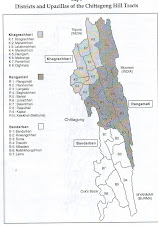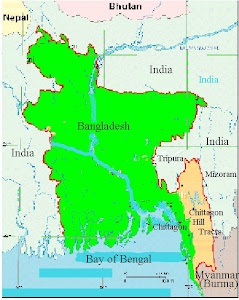Bangladeshi NGOs address education gap for minorities
Tuli Dewan
Chittagong Hill Tracts, Bangladesh - Participation by minorities in
development efforts is essential for dispersing the fruits of
development to all segments of society equally. But a culture of
minority participation in the national development effort is not often
found in Bangladesh and important segments of society are left without
the tools to participate. However local non-governmental organisations
(NGOs) are working to fill this gap.
Bangladesh is a predominantly Muslim country with the fourth largest
concentration of Muslims in the world. Other religious, linguistic and
cultural groups in the country – Buddhists, Hindus, Christians and
animists – constitute 10 percent of the total population. Established
as a parliamentary democracy, reflective of the country's religious
diversity and pluralist character, Islam was made the state religion
in 1988 and the present government has been operating in a state of
emergency since January 2007.
The people of Bangladesh are not as homogenous as many assume, and
most ethnic minorities are incidentally trapped in social
underdevelopment.
Though education has been recognised as a universal and fundamental
human right, quality education continues to elude indigenous learners
in the Chittagong Hill Tract (CHT) region of Bangladesh. Inadequate
educational resources coupled with high drop-out rates – with almost
20 percent of drop-outs attributed to linguistic obstacles – create an
environment where inhabitants are neither benefiting from development
efforts, nor are they equipped to participate in them.
The CHT region, located in the southeast corner of Bangladesh has an
area of 5,092 square miles and is home to 11 ethnic minorities who
differ from the population in the neighbouring plains not only in
terms of geographical setting but also in ethnicity, socio-economic
status, language, culture, religion, lifestyle, customs and tradition.
Chakma is the largest indigenous ethnic group in the CHT, and the
predominant language spoken, followed by Marma, which is spoken in the
southern part of the region in addition to local languages. However,
primary school children in the CHT are required to take classes in
Bengali – the state language. This linguistic barrier makes it
difficult for them to understand textbooks or follow their teachers'
lessons. School becomes boring for them and eventually they start to
lose interest in learning.
Linguistic challenges in elementary school naturally impact higher
education. Problems in understanding the language at this early stage
result in weak learning, whereas curriculum becomes easier for
students to understand when education is offered in a child's mother
tongue. This helps unlock a child's intuition, power of thought and
imagination.
Although the 40th session of the International Labour Organisation in
1957 adopted a resolution (Article 23(1) of Convention 107) that
clearly provides for indigenous children's education in their
respective mother tongues, little has been done by the government to
implement this. Moreover, Article 33 (kha) of the CHT Accord signed by
the Bangladesh government and Parbartty Chttagram Jana Sanghati Samity
(PCJSS), a regional political party that spearheaded the movement for
indigenous rights, also provides for primary education in indigenous
languages. And Article 17 of the Bangladesh constitution stipulates
that all children should receive an education that is compatible with
the needs of the society – indicating that there is no legal barrier
to providing education in regional languages.
In the absence of government assistance, a few NGOs have launched an
initiative to teach Chakma, Marma and Tripura children in their
respective languages at the pre-school stage in a few schools in and
outside the municipality area.
This struggling initiative will likely only succeed with support from
the national government and would benefit from assistance from
international donors. However, if successful, this initiative could
prove a model for other countries with linguistically diverse
populations that suffer from development challenges in multiethnic,
multicultural societies.
###
* Tuli Dewan is a programme manager for Green Hill (www.greenhill-
cht.org), a non-governmental organisation in the Chittagong Hill Tract
region of Bangladesh. This article was written for the Common Ground
News Service (CGNews) and can be accessed at www.commongroundnews.org.
Sources- http://groups.google.com/group/soc.culture.bangladesh/browse_thread/thread/e4c58da478d31a67/a2226567d7633280?hl=en&q=chakma
skip to main |
skip to sidebar


Map of Bangladesh

CHTs is number one Milliary zone in the world


Ministry of Chittagong Hill Tracts Affairs
The United Nation
The IJPMNA
This page provides information of the minority Indigenous Jumma Peoples in Chittagong Hill Tracts (CHTs) Bangladesh.
Contact with this please write:-ijpnusa@yahoo.com
Contact with this please write:-ijpnusa@yahoo.com
About Us
Location of Jummaland

Jumma Videos
- The BANDARBAN SADAR
- The Rowangchari
- The Ruma
- The Lama
- The Thanchi
- The Alikadom
- The Naikhkhongchari
- The RANGAMATI SADAR
- The Baghaichari
- The Langudu
- The Nanyachar
- The Barkal
- The Jurachari
- The Bilaichari
- The Kaptai
- The Rajsthali
- The Kawkhali
- The KHAGRACHARI SADAR
- The Manikchari
- The Laksmichari
- The Mahalchari
- The Matiranga
- The Ramgarh
- The Dighinala
- The Panchari
Audio & Video
Jumma Natok (Drama)
International Support
Educational Institution
Religious Organization
Buddhist Studies

Map of Bangladesh
Mission of Bangladesh
About Bangladesh
Bangali Audio Songs
Bengali News

CHTs is number one Milliary zone in the world
Online Audios
Refugee in Homeland

Jumma Picture

Blog Archive
About Me
- The Indigenous Jumma Peoples Movement in North America
- The Chittagong Hill Tracts (CHT) region comprises three districts: Banderban , Khagrachari and Rangamati. The districts comprise seven main valleys formed by the Feni, Karnafuli, Chengi, Myani, Kassalong, Sangu and Matamuhuri rivers aid their tributaries and numerous hills, ravines and cliffs covered with dense vegetation, which are in complete contrast to most other districts of Bangladesh, which consist mainly of alluvial lands. Geographically the CHT can be divided into two broad ecological zones: (a) hill valley, (b) agricultural plains. It is surrounded by the Indian states of Tripura on the north and Mizoram on the east, Myanmar on the south and east and Chittagong district on the west.
